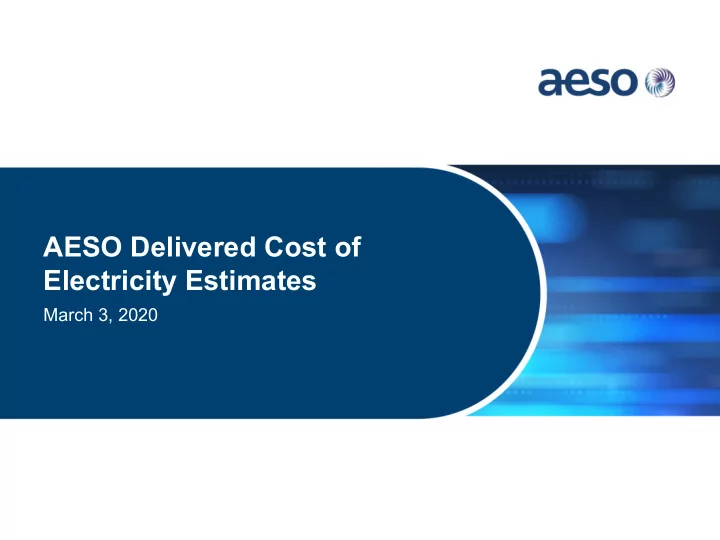

AESO Delivered Cost of Electricity Estimates March 3, 2020
Introduction • The AESO prepared a review of the delivered cost of electricity and self-supply options • Calculations were performed by the AESO’s Forecasting & Analytics team, reflecting AESO and Distribution Facility Owner tariff costs and electricity commodity costs at 5-year intervals – Time-series provides perspective to the changes in delivered electricity cost over the past decade – Reflects comparative costs of grid-connected self-supply options based on a range of rates of return on capital – Demonstrates the delivery costs associated with Critical Transmission Infrastructure 2 Public
Delivered cost of electricity Average Delivered Cost of Electricity by Customer Class 350.00 Delivered Cost of Electricity, $/MWh 300.00 250.00 200.00 150.00 100.00 50.00 - 2009 2014 2019 Residential Small/Med Commercial Large Commercial Industrial Tx Connected • The delivered cost of electricity has a wide range for smaller customers, driven by distribution tariffs in different service territories • Delivered electricity is cheaper for high-volume consumers • Costs have trended upward for all customer classes in the past decade Note: graphic line are based on an average of ENMAX, EPCOR, Fortis, and ATCO customers and the whiskers represent the high/low for each customer class 3 Public
Delivered cost of electricity Average Delivered Cost of Electricity for Various Customer Classes (2009-2019) 250.00 200.00 Delivered Cost of Electricity, $/MWh 150.00 100.00 50.00 - 2009 2014 2019 2009 2014 2019 2009 2014 2019 2009 2014 2019 Residential Small/Med Commercial Large Commercial Industrial Tx Connected Transmission Distribution Administrative Charge Local Access Fee Energy • The fastest growing components of the delivered cost of electricity relate to transmission and distribution • Low-volume consumers face substantially higher transmission and distribution cost than high-volume consumers 4 Public
Delivered cost of electricity Average Annualized Growth Rates of Commodity and Delivery Charges 30% 27% 25% Average Annualized Growth Rate, % 20% 14% 15% 13% 11% 9% 10% 8% 5% 5% 4% 4% 4% 5% 3% 3% 3% 3% 3% 2% 1% 1% 1% 1% 1% -2% -1% 0% 2009-2014 2014-2019 2009-2014 2014-2019 2009-2014 2014-2019 2009-2014 2014-2019 -5% Residential Small/Med Commercial Large Commercial Industrial Tx Connected Distribution & Transmission Energy Total Delivered Cost of Electricity • Distribution & transmission costs increased rapidly between 2009 and 2014, as Critical Transmission Infrastructure was commissioned • From 2014 to 2019, the increases in distribution & transmission costs moderated slightly, but still remained above inflationary levels • Energy (commodity) costs have increased modestly for most customers during the past decade 5 Public
Delivered cost of electricity 2019 Average Delivered Cost of Electricity for Various Customer Classes: Grid-Supplied vs. Self-Supplied with Rates of Return Between 0% and 10% 350.00 300.00 Delivered Cost of Electricity, $/MWh 250.00 200.00 150.00 100.00 50.00 - 0% 5% 10% 0% 5% 10% 0% 5% 10% 0% 5% 10% Grid- Self-Supplied Grid- Self-Supplied Grid- Self-Supplied Grid- Self-Supplied Supplied Supplied Supplied Supplied Residential Small/Med Commercial Large Commercial Industrial Tx Connected Transmission Distribution Administrative Charge Local Access Fee Energy Distributed Generation Capital • Delivered electricity costs have increased, while self-supply costs have declined significantly over the last decade • Self-supply costs for residential and commercial customers were measured based on solar photovoltaic costs, while large commercial and industrial self-supply costs options were measured based on natural gas generation • Self-supply options were measured at levels of 0 per cent, 5 per cent, and 10 per cent return-on-capital – Some customers may be better off to self-supply their electricity depending on return expectations • Self-supply represents a grid-connected customer, not an islanded consumer • From an economic perspective, the assessment doesn’t capture qualitative costs of self-supply, like increased operational complexity 6 Public
Recommend
More recommend